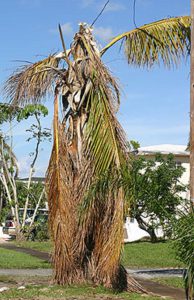A common question after a tropical storm or hurricane event is will my palm tree recover? Palms grow different from other trees, so there’s definitely a different way to care for them post-storm.
The growing point of a palm tree is the bud, located in the top of the tree. This is where the palm fronds emerge. If this bud area becomes damaged, no new leaves will develop and unfortunately the tree will die. If by chance the palm tree has multiple-stemmed trunks, the undamaged trunk(s) should survive. Often times palm trees are so tall that it is very difficult to visibly determine if the bud has been damaged. Time will tell.
It’s important to wait at least 6 months to see if palms develop new growth. Palms usually rebound slowly after a storm. It may take a couple of years before the palm tree produces a full canopy of fronds. If a damaged palm tree is determined to be in peril and current rainfall is not sufficient, it’s important to irrigate three times a week for at least six weeks to assist in recovery.
After the storm strikes, it may be beneficial to perform pruning of the canopy. Start by removing any hanging broken or dead fronds that could be hazardous to people or property. It’s a good idea to remove any fronds that are covering the bud, as well. This will allow new fronds to form. Leave any bent green fronts attached. These fronds still have vital nutrients that the tree is utilizing. Once the frond turns brown, then it is safe for removal.
Storm damage cleanup is extremely dangerous, even for professionals. During cleanup after the storm, remember that safety comes first. Some general safety tips are essential, as in, do not work alone. It’s important to keep a well-stocked first aid kit too. Avoid overexertion at all costs. This is the most common cause leading to injury. Be sure to survey the area, identify the hazards and have a plan for the cleanup. Above all, create a safe area to work within.
Palm tree recovery from storms is a slow process, so please be patient and safe. Contact your local county extension office for more information.
Supporting information for this article can be found in the following the UF/IFAS publications:
“Assessing Damage and Restoring Trees After a Hurricane” by Edward F. Gilman, Mary L. Duryea, Eliana Kampf, Traci Jo Partin, Astrid Delgado & Carol J. Lehtola: http://monroe.ifas.ufl.edu/pdf/Hort/Assessing_Trees_After_Hurricane.pdf
An Equal Opportunity Institution.
- Growing Shiitake Mushrooms - March 6, 2024
- Chinese Cabbage Becoming Increasingly Popular in Panhandle Gardens - January 4, 2024
- Mangroves, not just for South Florida anymore - September 20, 2023

